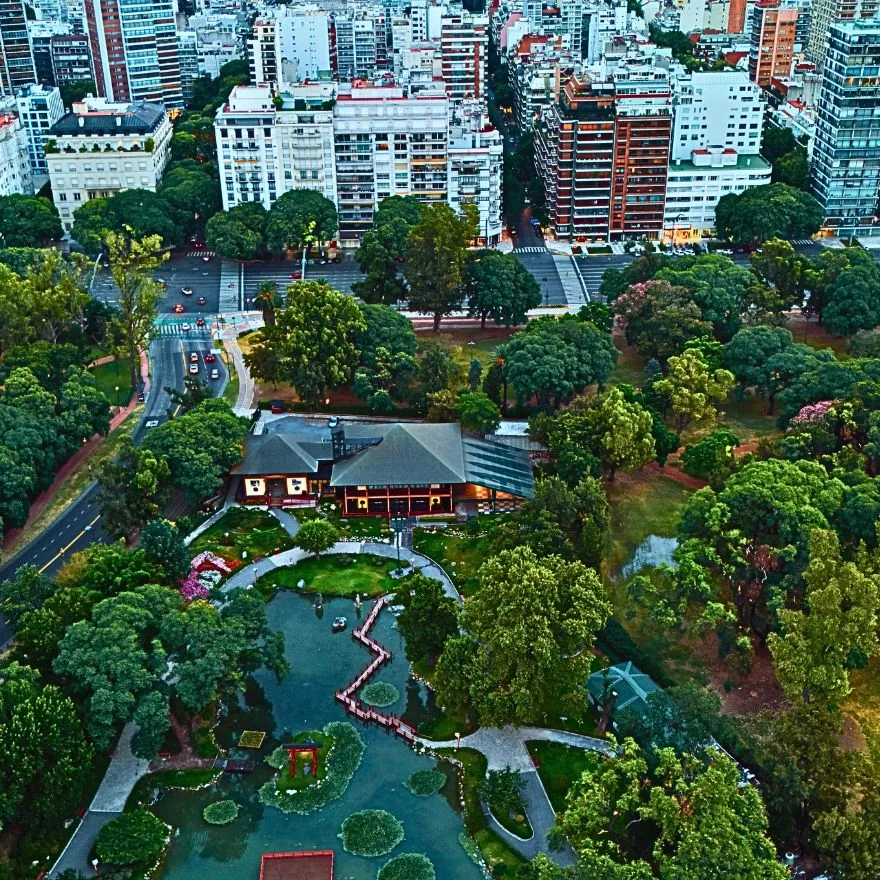
I arrived in Buenos Aires with my heart drumming in anticipation, as though it already knew the rhythm of tango that would soon surround me. The city unfurled itself slowly, like a melody rising at dawn—streets alive with whispers of history, cafés humming with conversation, and the Río de la Plata stretching wide and silver under the sky. From the moment my plane touched the runway to the day I bid farewell, Buenos Aires was more than a destination; it was an embrace, a journey through stories woven in music, architecture, and flavors that lingered on my tongue long after departure.
This was my seven-day voyage, a living diary of a traveler swept into the arms of Argentina’s capital.
Day 1 – First Breath of the City
The airport doors opened to a breeze tinged with warmth and something familiar yet new. The taxi ride into the city was a passage from stillness into vibrancy—bustling avenues lined with jacaranda trees, their violet blossoms raining over sidewalks. My driver pointed out the Obelisco, rising proudly on Avenida 9 de Julio, the world’s widest avenue, as if Buenos Aires was immediately offering me its heart.
Checking into my hotel in Palermo, I was struck by the neighborhood’s charm: leafy boulevards, murals splashed with color, and cafés spilling music onto the street. That evening, I wandered aimlessly, sipping my first café con leche and tasting a medialuna, Argentina’s sweeter, softer cousin of the croissant. The city felt alive yet gentle, welcoming me into its rhythm.
Day 2 – Plaza de Mayo: Where History Speaks
My first full morning began at Plaza de Mayo, the political soul of Argentina. Standing in the shadow of the Casa Rosada, the pink-hued presidential palace, I felt the pulse of history. This was where the Mothers of the Plaza de Mayo marched for their missing children, where revolutions sparked, and where Argentina’s story continues to be told.
The square was framed by architectural treasures—the neoclassical Catedral Metropolitana and the stately Cabildo, once the seat of colonial government. As I lingered, pigeons swirled overhead, and the echo of chants from past demonstrations seemed to ride on the breeze. Buenos Aires, I realized, is a city where history doesn’t sit still—it marches, sings, and demands to be remembered.
Day 3 – San Telmo: The Soul of Tango
San Telmo was a dance in itself. Cobbled streets, antique shops, and wrought-iron balconies made me feel like I had stepped into another time. At the San Telmo Market, I wandered past stalls of fresh produce, vintage treasures, and leather goods, the air rich with the scent of grilled meats.
That evening, I slipped into a dimly lit tango hall. The music began—bandoneón sighs and violins trembling—and couples glided across the floor with a passion that silenced all else. Tango here is not performance; it is life, a dialogue between two souls. Watching it unfold, I felt both an outsider and a participant, as though the dance had reached across the floor to sweep me into its embrace.
Day 4 – La Boca and Caminito: A Street of Colors
La Boca greeted me like a painter’s dream. The streets burst with life—houses painted in bold blues, yellows, and reds, a tradition born from leftover paint used by immigrant dockworkers. Caminito, the pedestrian street, pulsed with music, tango dancers performing in the open air, and artisans selling their crafts.
But beyond the colors lies history: La Boca was the cradle of Italian immigrants, their resilience and spirit etched into every corner. And for football lovers, it is sacred ground—the home of Boca Juniors, where Diego Maradona once ignited stadiums with his genius. La Boca is both celebration and struggle, a canvas that tells Buenos Aires’ immigrant story with unapologetic vibrancy.
Day 5 – Recoleta Cemetery: Silent City of the Dead
If life in Buenos Aires dances, its silence resides in Recoleta Cemetery. Entering its gates, I was enveloped by avenues of marble mausoleums, each more ornate than the last. Angels, crosses, and columns stood as guardians of Argentina’s past.
Here rests Eva Perón, beloved Evita, whose legacy still divides and unites. As I stood by her tomb, flowers laid carefully by admirers, I felt the gravity of devotion that continues decades after her death. Recoleta is not morbid but poetic—a city within a city, where stone whispers of love, power, and remembrance.
Day 6 – Palermo Parks and Botanical Gardens
In need of quiet after the intensity of history and color, I wandered into Palermo’s green heart. The Bosques de Palermo unfolded with rose gardens, reflective lakes, and families enjoying picnics under the sun. The Japanese Garden offered serenity—red bridges arching over koi ponds, bonsai trees sculpted with patience.
Here, Buenos Aires showed me its softer face, a reminder that even the most energetic city needs its breath of stillness. I spent hours beneath the jacarandas, watching petals drift like violet snow, feeling time pause just enough for me to breathe in gratitude.
Day 7 – Teatro Colón: The Final Curtain
On my last day, I saved a treasure—the magnificent Teatro Colón. Its grandeur took my breath away: chandeliers glimmering, marble staircases curving upward, and a ceiling painted like a portal to another world. Considered one of the finest opera houses on earth, its acoustics are so perfect that every note finds your heart.
I joined a guided tour, imagining the voices of Pavarotti, Callas, and countless others who once graced its stage. To end my journey here felt fitting, as though Buenos Aires itself had invited me to its most intimate performance—a final crescendo before my departure.
Flavors of Buenos Aires: A Feast of Memory
Food became as much a guide as the streets themselves. I devoured empanadas, their golden crusts bursting with beef and spice. Asado, the Argentine barbecue, was more than a meal—it was an event, a gathering of laughter and smoky aromas rising from the grill.
In San Telmo, I tried choripán—a sausage sandwich drizzled with chimichurri, bold and unforgettable. Sweetness came in the form of dulce de leche, spread on toast, swirled in ice cream, and tucked inside pastries. And no day was complete without mate, the bitter herbal infusion passed hand to hand, teaching me that in Argentina, sharing is ritual.
The Best Season to Visit Buenos Aires
Buenos Aires wears many seasons, but spring (September to November) and autumn (March to May) reveal her at her finest. Spring brings jacaranda blooms that turn the city violet, while autumn wraps the parks in golden light. Summers can be humid, winters mild, but in spring and fall, the city feels alive, comfortable, and ready to welcome travelers with open arms.
Travel Tips for a Smooth Journey
- Public Transport: The Subte (metro) is efficient and affordable. A SUBE card is essential for buses and trains.
- Walking: Buenos Aires is best discovered on foot; wear comfortable shoes for its wide avenues and cobbled alleys.
- Language: Spanish is the melody of the city, though many locals understand English. A few Spanish phrases, however, open hearts.
- Safety: Like any large city, stay aware in crowded places, especially at night.
- Cash: While cards are widely accepted, small shops and markets may prefer pesos.
Freedom on the Road: Renting a Car with DiscoverCars
Though I mostly explored the city on foot and by metro, one of the best decisions for those wishing to go beyond Buenos Aires—perhaps to Tigre’s delta or the Pampas—is renting a car. With DiscoverCars, travelers can easily compare rental options, ensuring fair prices and flexibility. Having the freedom to wander at your own pace transforms the journey—every detour becomes an opportunity for discovery.
Staying Connected: Drimsim for Travelers
Navigating Buenos Aires’ vibrant streets, from locating hidden tango halls to finding the nearest parrilla, is smoother when connected. I found that Drimsim offered an easy and reliable solution—an international SIM card that works seamlessly across borders. No more hunting for local SIMs or worrying about roaming fees; just instant access to maps, translations, and the comfort of being connected wherever the city’s rhythm carried me.
Buenos Aires: A Farewell Etched in Memory
On my final morning, I walked once more through Palermo, past bougainvillea spilling from balconies and the scent of fresh bread drifting from bakeries. The city that had once been a stranger now felt like a confidant, one whose stories I would carry within me.
Buenos Aires is not merely visited—it is felt. In the sway of tango, the echo of chants in Plaza de Mayo, the flavors of asado, and the silence of Recoleta, I discovered a city that dances between memory and present, poetry and grit.
As my plane lifted above the Río de la Plata, I whispered a promise to return, for Buenos Aires is a song unfinished, a rhythm that continues to call.
🌍✨ This seven-day journey was not just travel—it was an unfolding of spirit, a reminder that the world’s cities do not merely exist; they sing, and if we listen closely, they teach us how to soar within.
Frequently Asked Questions about Buenos Aires
1. What is the best time of year to visit Buenos Aires?
The city shines brightest in spring (September–November) when jacarandas paint the streets violet, and in autumn (March–May) when golden leaves blanket the parks. Summers can be hot and humid, while winters are mild but less lively. If you long for gentle weather and blossoming beauty, spring and autumn are your seasons of choice.
2. How many days do I need in Buenos Aires?
A 7-day itinerary in Buenos Aires allows you to dive deeply into its spirit—tango nights, colorful barrios, historical landmarks, and serene parks. With less time, you can still taste its highlights, but a full week gifts you the luxury of moving at the city’s own rhythm.
3. Where are the best neighborhoods to stay in Buenos Aires?
For first-time visitors, Palermo offers leafy streets, cafés, and nightlife; Recoleta is elegant and historic; while San Telmo carries the soul of tango and bohemian charm. Each barrio whispers a different story—choose the one that resonates with your own.
4. What traditional foods should I try in Buenos Aires?
Begin with empanadas, golden and savory; indulge in a smoky asado, Argentina’s famous barbecue; taste a street-side choripán with chimichurri; and end with a swirl of dulce de leche in pastries or ice cream. Don’t forget to sip mate, shared among friends as a ritual of connection.
5. Is Buenos Aires safe for tourists?
Buenos Aires is generally safe for travelers, especially in well-visited neighborhoods. Like any large city, it’s wise to stay alert—keep valuables close in crowded areas, avoid flashing cash, and use registered taxis or rideshares at night. Embrace the city with awareness, and it will welcome you warmly.

